.
While perusing through old issues of Flying Saucer review, I stumbled across an article by Dr. Berthold Eric Schwarz with the title of “UFOs: Delusion or Dilemma?” The same article appeared in the October 1968 issue of Medical Times. In that article was a case that had a sketch, which Iooked eerily familiar (see sketch to right).
For those who might not see what I am talking about perhaps these sketches will refresh their memories. They are sketches by witnesses, who saw the Zond IV re-entry.3
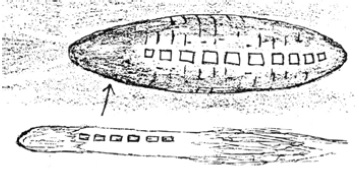
They are not alone. Jenny Randles put the following sketches together for her book “Danger in the air” revealing witnesses interpretation of the Cosmos 1068 re-entry on December 31, 1978.4
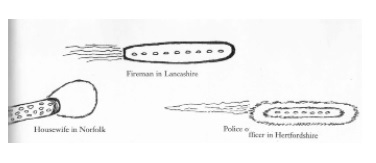
The UFO story
The description of events in Flying Saucer Review reads:
...at 8:15 p.m. on April 25, 1966, while driving with a friend, Charles Dayton, he noticed a “very awesome, huge, flaming body, which lit up a large area visible for a few seconds. It had a red flame with a green and yellow tail. The second view was of a dark object. The huge flames went out like turning off an electric bulb for a few seconds. There was a dim light in four port holes, and then all darkness. It looked like it was 250 ft. in front of us and 250 ft. up, and it could go at terrific speed. It was about 25 ft. in length and had a tail 35ft. long (see Fig. 3).
The contractor did not detect any odour, but he recalled how warm he felt. He noted that the automobile engine stalled and the lights went out. He soon started the engine again. “ I never saw such a sight.
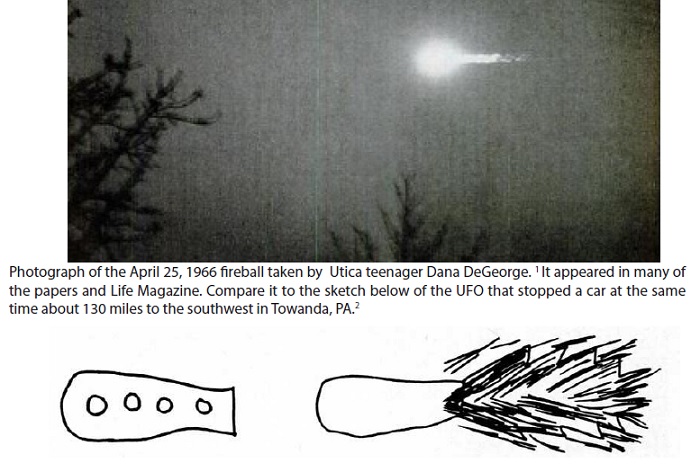
I was amazed and flabbergasted.” He and his friend were concerned the object would crash into the side of the mountain...5
This is quite an interesting story but the sketch is just too similar to the Zond IV and Cosmos 1068 sketches to be ignored so I decided to check the newspaper archives and bluebook files to see what I could find.

The source
It did not take much searching to find a source for the UFO. I am not sure how much research Dr. Schwarz performed but a cursory check of the media reports on April 26, 1966 indicated a bright fireball was visible all over the northeastern United States on April 25, 1966 around 8:15 PM.
The reports received for this fireball are most interesting. The duty officer at Stewart AFB reported they initially received reports that a plane had crashed, which is common in many fireball sightings. That description appeared in many of the papers. One individual even stated he saw two planes crash in mid-air. Another report to Stewart AFB had the witnesses describing as “funnel-shaped”. In Rhode Island, a woman reported that she called Quonset Point Naval base and they said they would send jets after it. Several reports mirrored the Towanda drawing by describing portholes in a larger craft. One woman called the newspaper demanding they do something because everyone at her location was frightened by the event!
The amusing thing about this is that many people were reported as being skeptical of the meteor explanation. This included a Utica teenager who managed to photograph the fireball. 6

Like so many first time witnesses to these events, they had no idea how bright and slow a fireball can be.
This meteor was widely photographed. The May 6th, 1966 edition of Life Magazine published many of them. From these photographs and films, a rough orbit was computed and published in the Journal of the Royal Astronomical Society of Canada (1968 Vol 62 p. 55). The data indicates the object was a meteor and not re-entering space debris.
Is it just a coincidence that a bright UFO, that was described as a flaming object that lit up the area, was seen at the same time? It seems that this UFO and the fireball were one in the same. Why the vehicle and lights went out is hard to determine but I doubt that the meteor did it. I can think of a couple of ways for a car to stop and the lights to go dim without the need of a UFO.
What is interesting is how this case was interpreted by UFOlogists. For some reason the fireball connection was ignored or missed.
Contamination?
Trying to see if there was more information about the case elsewhere, I discovered that there was a brief mention on NICAP’s 1966 UFO chronology web page:
Night. As their car engine and headlights failed and they felt heat, motorists saw a UFO with four portholes hovering about 350 feet away, flames shooting off of it.7
Somehow the distance moved from 250 to 350 feet away and was hovering instead of moving at terrific speed. Of course, if it were “hovering”, it probably would not be considered to be caused by a meteor. However, the Schwarz article never mentions any hovering so I pulled the string on the source for this entry.
This entry came from Mark Rodeghier’s “UFO Reports Involving Vehicle Interference: A Catalogue and Data Analysis”, which should be expected to be accurate. I found his catalogue and discovered the same errors in distance and “hovering” appearing in Rodeghier’s document so one can not fault NICAP’s chronology. Rodeghier cites as his source for this report as being from John Keel’s book, “Operation Trojan Horse”.
Now if I were an academic, I would think that I would make sure that Keel had his ducks in a row. Before opening Keel’s book, I expected to see the same errors found in the Rodeghier document. I was shocked to see Keel describing something completely different:
On a highway near Towanda, Pennsylvania, Robert W. Martz and a, friend saw the object scoot overhead. Simultaneously, their automobile engine stalled, and the headlights went out. Both men complained of feeling a wave of heat as they watched “a very awesome, huge flaming body which lit up a large area, visible for a few seconds. Then the second view was of a dark object. The huge flames went out like turning off an electric bulb for a few seconds . There was a dim light in four portholes, and then all darkness. It looked like it was 250 feet in front of us and 250 feet up, and it could go at terrific speed .“8
This sounds a lot like the original story in Flying Saucer Review and there is no mention of the UFO “hovering”. The fault lay in Rodeghier’s interpretation of what was written. Even more interesting is that Keel was describing the event as being suspected as a bright fireball. Didn’t Rodeghier bother to check this before putting it into a UFO database that others would cite as being thoroughly investigated? It seems that Dr. Rodeghier may not have researched this case very well.
If this one case was poorly researched, what does it say for all of his other cases? I am not stating that all in the database should be dismissed but it demonstrates that one should not blindly accept such cases and databases as being vetted just because it comes from one of UFOlogy’s leading scientists.
What does this mean?
Aside from the problem associated with these sources not performing due diligence in their research, what else does this case tell us? The obvious one comes from the sketches. Dr. Hartmann, writing in the Condon report, suggested the comparison between the Zond IV sketches/reports and that of the Chiles-Whitted sighting of 1947. If that was produced by a bright fireball, are there any others that might be on the list as potential fireballs?
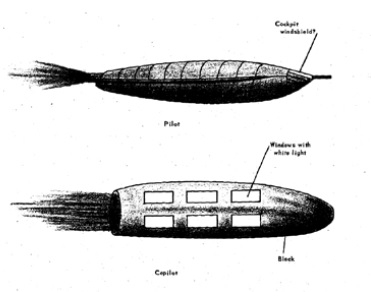
Drawings by Chiles and Whitted of their UFO encounter in July 1948. 9
Perhaps one can see similarities between these sketches and two sketches by the air crew in the Coyne helicopter-UFO encounter. Phil Klass suggested it was a bright fireball but that has been dismissed as a good explanation by UFOlogists for various reasons. The sketches are similar and makes one think twice about the fireball explanation.
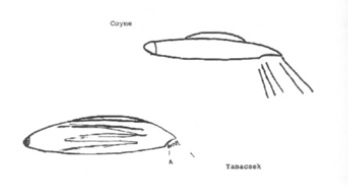
Sketches by Coyne and Yanacsek of their UFO10
Fireballs and re-entries redux
Does this mean that ALL cigar-shaped UFOs are caused by meteors and re-entering space debris? Absolutely not but one has to give serious consideration for such an explanation when one sees such reports and drawings. The existence of all sky meteor networks/cameras becoming more widespread indicates that such reports should be readily solved. Older cases like Chiles-Whitted and Coyne are more difficult to solve. The time of those events were much later at night when the public is less likely to be out. Amateur astronomers do tend to fill the gap when they are out observing. However, if nobody was out observing that night, it would not exist in the records. Without a positive/negative report from experienced meteor observers, who were in a position to observe a fireball, one can only suggest the possibility that a meteor was the cause.
Notes and references
DeGeorge, Dana. “A meteor in full 1. view”. Life Magazine May 6, 1966. Page 43.
Schwarz, Berthold Eric. “UFOs; Delu2. sion or Dilemma?” Flying Saucer Review: Beyond Condon Special Issue no. 2. Bowen, Charles ed. June 1969. Page 49.
Klass, Philip. 3. UFOS Explained. New York: Random House, 1974.
Quelle: SUNlite 3/2014
